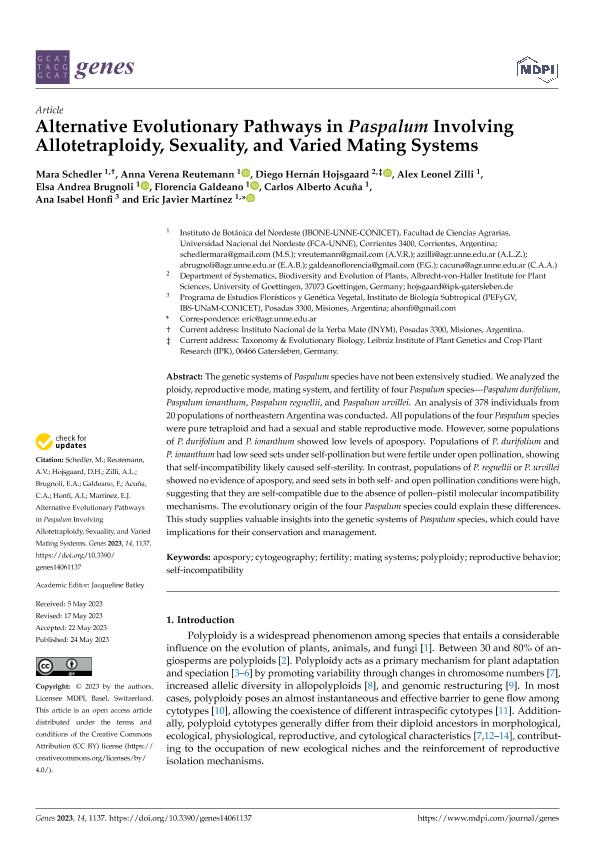Artículo
Alternative Evolutionary Pathways in Paspalum Involving Allotetraploidy, Sexuality, and Varied Mating Systems
Schedler, Mara ; Reutemann, Anna Verena
; Reutemann, Anna Verena ; Hojsgaard, Diego Hernán; Zilli, Alex Leonel
; Hojsgaard, Diego Hernán; Zilli, Alex Leonel ; Brugnoli, Elsa Andrea
; Brugnoli, Elsa Andrea ; Galdeano, Florencia
; Galdeano, Florencia ; Acuña, Carlos Alberto
; Acuña, Carlos Alberto ; Honfi, Ana Isabel
; Honfi, Ana Isabel ; Martínez, Eric Javier
; Martínez, Eric Javier
 ; Reutemann, Anna Verena
; Reutemann, Anna Verena ; Hojsgaard, Diego Hernán; Zilli, Alex Leonel
; Hojsgaard, Diego Hernán; Zilli, Alex Leonel ; Brugnoli, Elsa Andrea
; Brugnoli, Elsa Andrea ; Galdeano, Florencia
; Galdeano, Florencia ; Acuña, Carlos Alberto
; Acuña, Carlos Alberto ; Honfi, Ana Isabel
; Honfi, Ana Isabel ; Martínez, Eric Javier
; Martínez, Eric Javier
Fecha de publicación:
05/2023
Editorial:
MDPI
Revista:
Genes
ISSN:
2073-4425
Idioma:
Inglés
Tipo de recurso:
Artículo publicado
Clasificación temática:
Resumen
The genetic systems of Paspalum species have not been extensively studied. We analyzed theploidy, reproductive mode, mating system, and fertility of four Paspalum species?Paspalum durifolium, Paspalum ionanthum, Paspalum regnellii, and Paspalum urvillei. An analysis of 378 individuals from 20 populations of northeastern Argentina was conducted. All populations of the four Paspalum species were pure tetraploid and had a sexual and stable reproductive mode. However, some populations of P. durifolium and P. ionanthum showed low levels of apospory. Populations of P. durifolium and P. ionanthum had low seed sets under self-pollination but were fertile under open pollination, showing that self-incompatibility likely caused self-sterility. In contrast, populations of P. regnellii or P. urvillei showed no evidence of apospory, and seed sets in both self- and open pollination conditions were high, suggesting that they are self-compatible due to the absence of pollen?pistil molecular incompatibility mechanisms. The evolutionary origin of the four Paspalum species could explain these differences. This study supplies valuable insights into the genetic systems of Paspalum species, which could have implications for their conservation and management.
Archivos asociados
Licencia
Identificadores
Colecciones
Articulos(IBONE)
Articulos de INST.DE BOTANICA DEL NORDESTE (I)
Articulos de INST.DE BOTANICA DEL NORDESTE (I)
Articulos(IBS)
Articulos de INSTITUTO DE BIOLOGIA SUBTROPICAL
Articulos de INSTITUTO DE BIOLOGIA SUBTROPICAL
Citación
Schedler, Mara; Reutemann, Anna Verena; Hojsgaard, Diego Hernán; Zilli, Alex Leonel; Brugnoli, Elsa Andrea; et al.; Alternative Evolutionary Pathways in Paspalum Involving Allotetraploidy, Sexuality, and Varied Mating Systems; MDPI; Genes; 14; 6; 5-2023; 1137-1159
Compartir
Altmétricas



